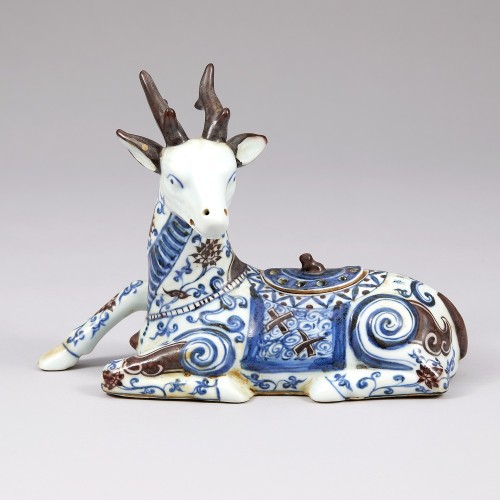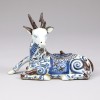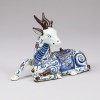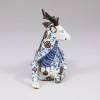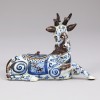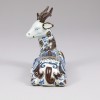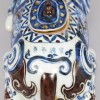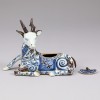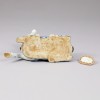작품 정보
이 향로는 명나라 선덕 연간(1426~1435)에 제작된 백자 향로로, 사슴을 본뜬 조형미와 청화, 철채 기법이 조화를 이루는 유물입니다. 사슴은 네 다리를 굽히고 온화한 자세로 앉아 고개를 돌려 앞을 응시하고 있으며, 등에는 작은 손잡이가 달린 뚜껑이 있어 내부에 향을 넣을 수 있도록 되어 있습니다. 향을 피우면 사슴의 코와 입, 그리고 등에서 연기와 향이 피어오르는 구조입니다. 실용적인 향로의 기능에 사슴의 형상을 더해 조형미를 한층 높이고 있습니다.
이처럼 동물 형상의 향로는 주로 궁중이나 귀족의 장식용 공예품으로 제작되었을 가능성이 높습니다. 특히 이 향로는 온전한 형태로 발견되어, 왕족이나 귀족의 부장품이었을 것으로 추정됩니다. 명대 선덕 연간의 청화자기 제작 기술이 매우 뛰어났음을 잘 보여주고 있습니다.
이 사슴 모양 향로는 화려한 문양으로 장식되어 있어 뛰어난 예술적 감각을 드러냅니다. 사슴의 몸체는 회회청을 사용한 청화 기법으로 다양한 문양이 시문되었고, 뿔과 귀, 꼬리 등은 철채로 부분적으로 채색되어 있습니다. 몸체에는 기하학 문양, 안장을 연상시키는 문양, 소용돌이 문양이 섬세하게 표현되어 있으며, 다리와 목 부분에는 보상화문이 정교하게 그려져 있습니다. 특히 사슴이 목을 돌린 자세는 맑고 선명한 청화 시문을 통해 입체적으로 묘사되어 있습니다. 사슴의 등에는 ‘선덕년제(宣德年製)’라는 명문이 새겨져 있어 제작 시기를 확인할 수 있습니다.
사슴은 길상의 상징으로 여겨집니다. 중국어에서 사슴을 의미하는 '록(鹿)’은 '녹(禄, 고위 관직의 녹봉)'과 발음이 같아 재물과 지위를 의미하며, 신선이나 불로초와 함께 묘사될 때는 장수를 상징하기도 합니다. 이에 이 사슴 향로는 부귀와 명예, 출세를 상징하며, 고귀한 신분의 귀족이나 왕족이 사용했을 것으로 보입니다.
━━━━━
此香炉制作于明代宣德年间(1426-1435年),鹿形,并融合青花与铁绘技法。鹿四肢收起、坐姿温和,转头并凝视前方,背部盖顶置钮,方便放入香料。点燃香料后,香气会从鹿的鼻子、嘴巴和背部散发出来,设计巧妙,兼具实用功能和艺术美感。
动物造型的香炉通常被认为是宫廷或贵族的装饰性工艺品。特别是这件香炉保存完好,推测可能是王族或贵族的随葬品,展示了明代宣德年间青花瓷制作技术的高超水平。
此鹿形香炉图案装饰精美,艺术卓越。鹿身以青花技法绘各种图案,鹿角、鹿耳、鹿尾部分铁绘。鹿身表现几何图案、类似鞍具的图案和漩涡图案,鹿的腿和颈部绘宝相花纹。特别是鹿转头的姿势以青花立体呈现。鹿背部署“宣德年制”款识,可知其制作时期。
鹿在中国传统文化中象征吉祥。“鹿”与“禄”同音,寓意财富和地位;同时,鹿也常与仙人或长生不老草一同出现,象征长寿。因此,此鹿形香炉象征富贵、荣誉和功成名就,可能是皇室或贵族使用之物。
━━━━━
This porcelain incense burner was crafted during the Xuande reign (1426–1435) of the Ming Dynasty. It is a striking example of artistic harmony, combining a sculptural form inspired by a deer with underglaze cobalt blue and iron-painted decoration techniques. The deer sits serenely with its legs tucked under, its head turned gently to gaze forward. A lid with a small handle is set on its back, allowing incense to be placed inside. When used, fragrant smoke gently wafts out from the deer’s nose, mouth, and back, a design that marries functionality with elegant form.
Incense burners shaped like animals were often produced as decorative craftworks for the imperial court or nobility. This particular piece is especially notable for its complete preservation, suggesting it may have served as a burial item for a member of the royal family or aristocracy. The high level of craftsmanship reflects the advanced porcelain techniques developed during the Xuande period.
The deer-shaped burner is richly adorned with ornate patterns, showcasing exceptional artistic sensibility. Its body features a variety of motifs rendered in cobalt blue, while details such as the antlers, ears, and tail are highlighted in iron pigment. The surface is embellished with geometric patterns, saddle-like motifs, and swirling designs, with the legs and neck delicately painted with floral scrolls. The lifelike posture of the deer turning its head is vividly brought to life through the crisp and vivid blue painting. An inscription reading “Made in the Xuande period” (宣德年製) is engraved on its back, confirming its date of manufacture.
In Chinese culture, the deer is a symbol of auspiciousness. The word for deer (lu, 鹿) is a homophone for lu (祿), meaning emolument or salary granted to high-ranking officials, and it also represents longevity when depicted with immortals or the fabled elixir of life. As such, this incense burner symbolized wealth, honor, and advancement in rank, making it a fitting possession for nobility or royalty.
CONDITION
NOTICE
상담/문의 : 02- 730-5601 / 02- 730-7566
